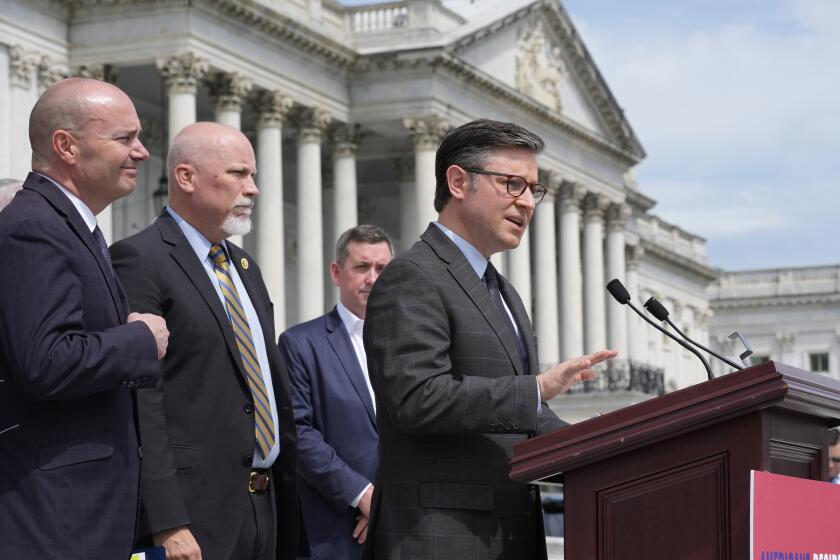Military May Face $3-Billion AIDS Crisis : Health: The cost of caring for infected personnel is called a ‘time bomb.’ The Pentagon has no plan for dealing with the issue, the GAO says.
By the year 2000, the military could be facing a $3-billion health care crisis over AIDS within its ranks and has made no provisions to deal with it, according to a 2 1/2-year study by the General Accounting Office released Monday.
The congressional watchdog agency said that, although AIDS has had a “minimal impact” on overall Department of Defense operations, it has had a “significant impact” on military hospitals, primarily because of the strains imposed by the department’s mass screening program for AIDS infection and by the care required by those already ill or infected.
“Medical officials at the hospitals we visited expressed concern about their ability to handle the increased workload and costs,” the study said. “Medical officials stated that military hospitals are generally designed to handle acute care patients rather than chronic, long-term care patients,” such as AIDS patients in the later stages of the disease.
The GAO said that, since 1985, more than 6,000 active duty personnel have been identified as being infected with the human immunodeficiency virus (HIV), and it forecast 1,500 to 1,700 new infections annually in the military.
The report criticized the Pentagon for failing to design an education program for its personnel that focuses on the modification of the high-risk behaviors that transmit the HIV that causes AIDS. AIDS is commonly transmitted through sexual intercourse and the sharing of contaminated hypodermic needles. In this country, the majority of AIDS cases have been among intravenous drug abusers, homosexual and bisexual men and their sexual partners.
The study, which was requested by the House Armed Services Committee and the House Small Business subcommittee on regulation, business opportunities and energy, “indicates that we may have a ticking budget time bomb,” said Rep. Ron Wyden (D-Ore.), chairman of the regulation subcommittee, who released the study.
“We’re robbing Peter to pay Paul, and sooner or later it will catch up to us in a general erosion of many care services at these military hospitals,” Wyden added.
The GAO recommended that the Pentagon develop financial, staffing and facility resource plans to meet the projected increases in patient workload, the demand for expensive prescription drugs such as AZT and aerosol pentamidine--which are used to treat early infection and prolong lives--and the growing need for more chronic-care services.
The Defense Department, after reviewing a draft of the report, wrote in a Feb. 16 letter to the GAO that it agreed with the agency’s recommendations and said it intends to improve its education program and order the services to plan more effectively for the coming health care burden.
David Newhall, special assistant in the department’s health affairs office, said that the department plans to issue a memorandum in April to the various branches of the military directing changes in the education program that will place an increased emphasis on high risk behaviors and safer sexual practices.
However, he warned that “the successful implementation of these recommendations may be impeded, because some behaviors associated with transmission of the virus are currently considered illegal or incompatible with military service.” It was a reference to a department policy that bans homosexuals from serving in the military.
Newhall said the department “will also direct the services to develop plans for the perceived increased demand for HIV-related medical care.”
In 1985, the department began testing all recruits and all active duty personnel for AIDS infection. As of last August, 6,269 of about 2.3 million active duty members were found to be infected. Fewer than 2,100 of the 6,269 remain on active duty, the report said. The others had retired, left the service or died, the study said.
From the beginning of the department’s testing program, 2,752 potential applicants were found to be HIV-positive and denied entry into the military, the study said.
The report said that in 1986 the Army, in response to a growing concern about AIDS, began keeping track of AIDS expenditures and estimated that the lifetime cost to the department of providing medical care to each HIV-infected service member ranged from $157,000 to $208,000. This estimate assumes that the incidence rate for personnel who test HIV-positive will remain constant and that 60% of the patients will seek health care within the military system.
More to Read
Start your day right
Sign up for Essential California for news, features and recommendations from the L.A. Times and beyond in your inbox six days a week.
You may occasionally receive promotional content from the Los Angeles Times.






